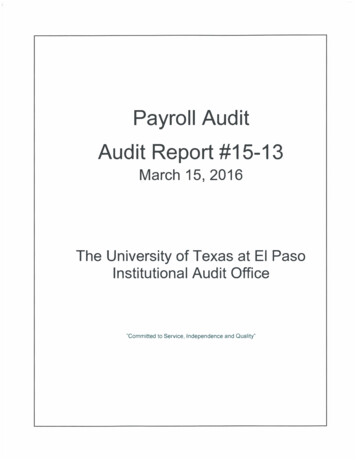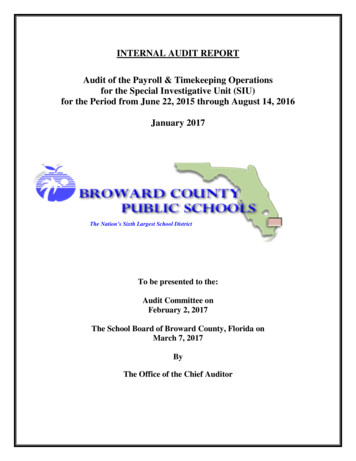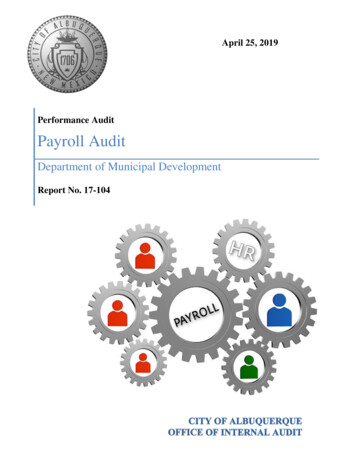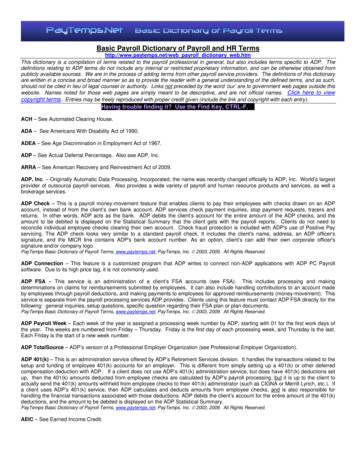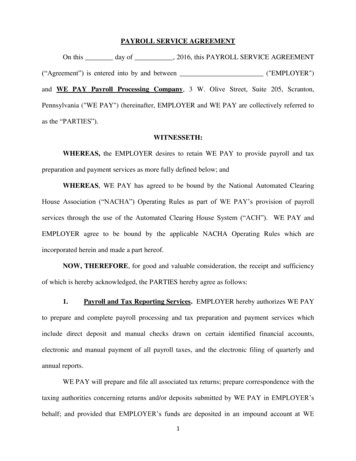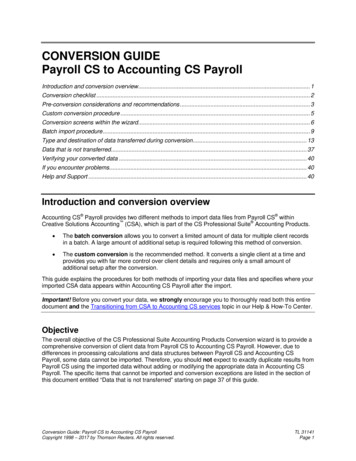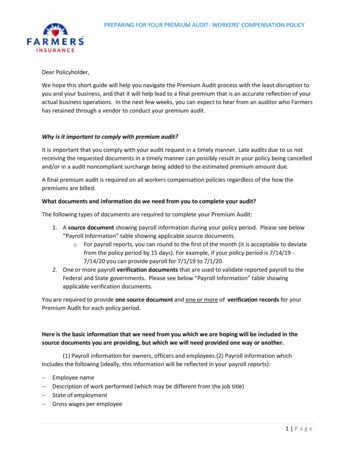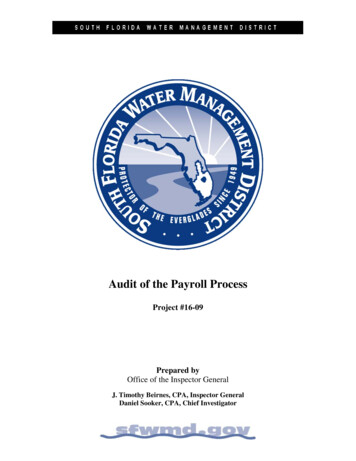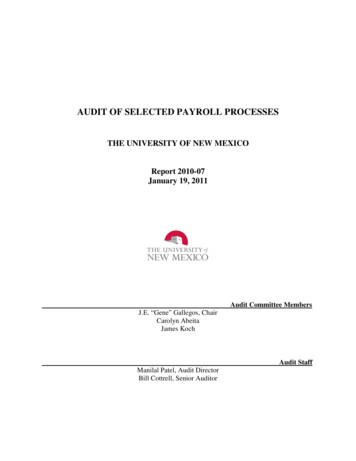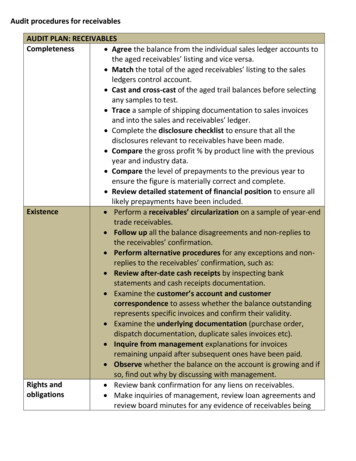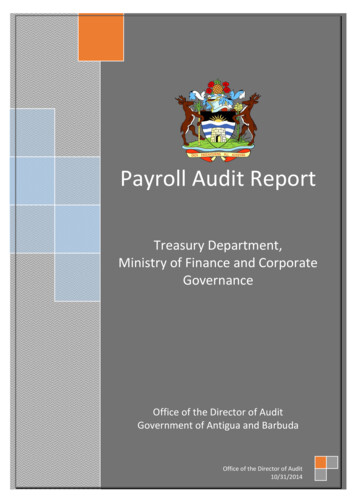
Transcription
Payroll Audit ReportTreasury Department,Ministry of Finance and CorporateGovernanceOffice of the Director of AuditGovernment of Antigua and BarbudaOffice of the Director of Audit10/31/2014
CONTENTSPage(s)BACKGROUND.3 33EXECUTIVE SUMMARY.4INTRODUCTIONIntroduction of Performance Audit.6 7Audit Motivation.6 7Audit Objective.7 7Audit Scope.8 8Audit Design.88Assessment Criteria.98Methodology. 10 8FINDINGS AND ANALYSIS.113CONCLUSIONS.24RECOMMENDATIONSThe way forward.25 34343638APPENDIX. 272Payroll Audit Report - Office of the Director of AuditOctober 2014
BackgroundThe Government of Antigua and Barbuda operates a centralized disbursement system forpayroll and payroll related cost through the Treasury Department. In 2006, an initiative wastaken to computerise the payroll process by introducing a Free Balance-Human CapitalAccountability system (FB-HCA).Free Balance is an online program designed to assist the government in aggregate fiscalcontrol and better management of public funds. The initial implementation was introduced atthe Treasury Department where the processing of payroll information for both Establishedand Non-Established workers was done. The intention was to eventually allow allGovernment departments access to input their payroll information into the system, while theTreasury Department would review and further process the said transactions.However, in June 2013 FB-HCA was upgraded to Civil Service Management (CSM). Withthe change over to CSM, the Treasury Department was only responsible for processingpayroll related payments for non-established workers, while the inputting and reviewprocesses for established workers were transferred to the Establishment Department.Since the implementation of the Free Balance at the Treasury Department, an audit has neverbeen conducted on the Payroll system. A audit would assess the impact of Free Balance onthe efficiency and effectiveness of the payroll process and establish the degree of accuracy ofthe information inputted into the Free Balance system. As a result of the aforementioned, theaudit was designed to assess the integrity of the payroll system at the Treasury Department,identify potential areas for improvement and to invoke a culture of independent review withinthe government service.3Payroll Audit Report - Office of the Director of AuditOctober 2014
EXECUTIVE SUMMARYThe implementation of Free Balance in 2006 and subsequent modifications to the programhave considerably improved the way business is done at the Treasury Department. Thecontinuous effectiveness however requires that management ensures that systems are in placeto minimize the potential occurrence of errors or fraud.With the significant amount of change forms that are processed by the Treasury andEstablishment Departments on a monthly basis, it is of utmost importance that sufficientpolicies and procedures are adopted and implemented by management to ensure efficiencyand accuracy of payroll information.The effective functioning of an internal audit unit presently located in the TreasuryDepartment should greatly mitigate the risk of errors and fraud. However, management needsto works along closely with the internal audit unit and act in a timely manner on therecommendations made.Key findingsErrors identified from the audit test were classified into four categories for detail analysis.These were: no action taken; incorrect entry; department error (ministry error) and systemfailure. Our aggregated results for the four showed that for 2013 there was a total of 24%error in the system; for 2012 there was a total of 20% error in the system; for 2011 there wasa total of 21% and a total of 16% error for 2010.These errors resulted from employees responsible for processing payroll, overriding thecontrols in the system to meet payroll deadlines. There is no existing policy or procedure toidentify errors independent of the payroll department and the department lacks a proceduresmanual which would standardize all payroll processes.The frequency of these errors in our findings would have been significantly reduced if theinternal audit unit was actively involved in identifying and correcting these errors in a timelymanner. However, internal audit unit is unable to operate optimally because of significantinternal issues the unit is currently facing.RecommendationsA procedures manual needs to be implemented by management urgently so that theprocessing of transactions is done in a standardized manner.There should be at least one person independent of the payroll unit, who is charged with theresponsibility of reviewing the payroll so that the errors identified can be corrected, at leastby the following payroll period.The Internal Audit Departments should perform frequent audits. However, it is recommendedthat payroll audit should be done at least once every three (3) years by the External AuditDepartment.4Payroll Audit Report - Office of the Director of AuditOctober 2014
Finally, it is advised that senior management should give significant consideration toimproving the efficiency and effectiveness of the internal audit unit, with a view to improvingtheir independence, effectiveness and contribution to risk identification.5Payroll Audit Report - Office of the Director of AuditOctober 2014
INTRODUCTIONMandate1. The primary duties and powers of the Director of Audit are outlined in theAntigua and Barbuda Constitution, 1981, section 97 and the Office of theDirector of Audit Act, 2014.2. In discharging his duties, the Director of Audit is required under the Antigua andBarbuda Constitution, 1981 section 97 (1) and (2) and the Office of the Directorof Audit Act, 2014, No. 4 of 2014, Part II section 9 that states:The Director of Audit shall (a) satisfy himself that all monies that have been appropriated by Parliament and disbursed havebeen applied to the purposes to which they were so appropriated and that the expenditureconforms to the authority that governs it.(b) at least once every year audit and report on the public accounts of Antigua and Barbuda, theaccounts of all officers and authorities of the Government, the accounts of all courts includingany accounts of the Supreme Court maintained in Antigua and Barbuda, the accounts ofevery commission established by the Constitution and the Clerks to the House ofRepresentatives and the Senate.Section 97 (3 and 4) of the Antigua and Barbuda Constitution, 1981 also states that:(3) The Director of Audit shall have the power to carry out audits of the accounts, balance sheetsand other financial statements of all enterprises that are owned or controlled by or on behalfof Antigua and Barbuda.(4) The Director of Audit and any other officer authorized by him shall have access to all books,records, returns, reports and other documents which in his opinion relate to any of theaccounts referred to in subsections (2) and (3) of this section.Section 9 (2) of the Office of the Director of Audit Act, 2014 states that the Director ofAudit shall satisfy himself that(a) all reasonable precautions have been taken to safeguard the collection and custody of revenueand that the law, directions and instructions relating thereto are duly observed;(b) expenditure is incurred with due regard to the economy and to the value obtained;(c) public moneys other than those appropriated are dealt with in accordance with the properauthority;(d) all reasonable precautions are taken to safeguard the receipt, custody, issue and proper use of6Payroll Audit Report - Office of the Director of AuditOctober 2014
cash, stamps, securities and stores and that the regulations, directions and instructionsrelating thereto are duly observed; and(e) that adequate regulations, directions or instructions exist for the guidance of any officer who isdelegated the duty of accounting officer.Key Principles of Performance AuditingAccording to International Standards of Supreme Audit Institutions, Performance auditing isexplained as an independent and objective examination of government undertakings, systems,programmes or organisations, with regard to one or more of the three aspects of economy,efficiency and effectiveness, aiming to lead to improvements.As a result of the centralized payroll system for civil servants; the process redesign that tookplace at Treasury Department over the past few years and the fact that payroll accounts forover 60% of Government’s monthly expenditure, it was necessary to conduct an audit of thisnature to give stakeholders some feedback on the degree of efficiency, effectiveness andeconomy of the payroll system at the Treasury Department for the years 2010 to 2013. Sincethe payroll process often starts at the department level it was necessary to obtain assurancethat persons involved at all levels of the process is adequately competent to handle theirduties. As such, audit testing was applied to all levels of the payroll process to give auditorssufficient information to produce greater analysis of the payroll system.Audit MotivationEach year the Director of Audit identifies a list of entities to be audited as a result of his riskassessment procedures. The Treasury Department was selected for the following reasons: The volume of transactions processed by the Treasury Department each month; The impact of material errors and possible misappropriation of public funds; Significant changes have been made relating to payroll processes over the past years andthere is a great need for an independent investigation of the systems at the TreasuryDepartment.Audit ObjectiveThe objectives of this audit were to:1.2.3.4.Test the degree of accuracy of the payroll information produced by theTreasury Department;Assess the level of competence of the persons involved in the entire payrollprocess;Assess the adequacy and appropriateness of the existing controls to safeguardagainst fraud and errors;Issue an independent opinion on the operational efficiency and effectivenessof the payroll systems at the Treasury Department covering the period January2010 and December 2013.7Payroll Audit Report - Office of the Director of AuditOctober 2014
Audit ScopeThe scope of the audit consists of the following: Capturing and processing information relating to established and non - establishedemployees - Payroll system at the Treasury Department; The degree of proficiency of the payroll officers at the various units within theTreasury Department; Review of internal payroll control procedures adopted by management; Data and evidences collected referring specifically to the period 2010 to 2013.Audit DesignThe main audit questions developed were as follows: Are the policies and procedures adopted and implemented at the Treasury Departmentsufficient and appropriate to prevent material fraud and errors from occurring in thepayroll unit? Are the employees at the Treasury Department adequately trained? Do the employees at the Treasury Department have reasonable understanding of thepolicies and procedures that governs the payroll process? Is the payroll system being used adequately by the Treasury Department? Are employees involved in the payroll process fully aware of the controls? Are the employees involved in the payroll process fully aware of the importance oftheir roles and responsibilities in the overall payroll process? Do the employees at Establishment Department and other related Departments (PublicWorks, Education and Central Board of Health), have adequate and competent staff toperform their duties?In order to achieve the objectives and answer these questions the audit was designed andperformed as follows:Stage 1 - Planning and Information GatheringThe main intention of gathering information at this stage in the audit was to assist in theoverall risk assessment process, so that high risk areas are given adequate attention. Thiswould minimise the risk of issuing an inappropriate opinion.8Payroll Audit Report - Office of the Director of AuditOctober 2014
Throughout this stage, an initial audit plan was designed based on the accumulatedknowledge and experience of the audit team, as well as the review of relevant laws andregulations governing the payroll process. However, the audit plan was continuouslymodified as additional information was obtained that gave greater understanding of theprocesses and procedures.Stage 2 - Performance (substantive stage)Following the information obtained and the risk areas identified in the audit plan, auditprocedures were performed to gain sufficient and appropriate audit evidence to formreasonable conclusions about the audit findings relating to the payroll system at the TreasuryDepartment.After gathering the information and identifying the high risk areas as outlined in the auditplan, audit procedures were performed to gain sufficient and appropriate audit evidence. Theaudit evidence is then used to form reasonable conclusions about the audit findings relating tothe payroll system at the Treasury Department.Stage 3 - Review and reportingAfter audit evidence was collected and analysed, the next stage of the audit was to carefullyreview the evidence and make recommendations for improvements where necessary. Thefindings and recommendations were reported to the relevant stakeholders for theirconsideration.Stage 4- MonitoringThe most efficient performance audit will certainly be considered ineffective if there are nofollow-up procedures in place. These procedures ensure that the audit recommendations aresufficiently considered and implemented and that adequate steps are taken by management tomitigate the potential impact of the risks identified.Assessment Criteria.The Finance Administration Act, 2006, The Finance Administration Regulations, 2010,manuals and recommendations from FreeBalance experts were used to assess the operation ofthe payroll system at the Treasury Department.Current practices were compared with what is expected through compliance with policies andprocedures set out by those charged with governance as well as the Free Balance experts.MethodologyDuring the audit engagement, payroll information from a sample of eight thousand, twohundred and forty-two (8,242) employees were reviewed. This sample consisted of 3,814established, 2,228 non-established monthly paid employees and 2,200 non-establishedweekly employees, who are employed at the various government ministries and departments.9Payroll Audit Report - Office of the Director of AuditOctober 2014
SamplingAudit procedures were applied on a random basis to less than 100% of the total transactionsfor the period audited. This was to obtain a representative sample that will give sufficientdetails of the entire population. Seven (7) departments were selected for the audit based on either the volume oftransactions generated by the department, their close connection and significantimpact on the payroll process. The following departments were selected for thesampling test - Treasury Department, Establishment Department, Ministry ofAgriculture, Ministry of Finance and Corporate Governance, Internal Audit, Ministryof Public Works and Central Board of Health.InterviewsUsing a standard questionnaire, structured interviews were carried out with key staff from thevarious departments, along with their supervisors, in order to gain an in-depth knowledge ofthe daily payroll function and the role they play in the overall payroll procedure.Document reviewsExtensive literature reviews were carried out to gain an understanding of the policies andprocedures that should be implemented and followed by the payroll personnel at the TreasuryDepartment.The following documents were reviewed: Free Balance ManualThe Civil Service RegulationThe Finance and Audit Act CAP 168The Finance Administration Act, 2006The Finance and Administration Regulations, 2010Data validation process (re-performance)This process involves going through the procedures that were used to get information in thepayroll system. Change forms and payments vouchers were used to add, delete or makechanges to civil servants' record and remuneration information. As a result of theaforementioned criteria, a sample of 384 items (change forms and payment vouchers) wereselected and traced to the data entered in the system. This was to verify proper authorisationand accuracy of the information selected.ObservationAn explanation was obtained and documented on the processes and procedures carried out inthe payroll department. Through observation, the auditors were able to assess the degree ofcompliance by the persons involved in the payroll process. By observing the activities of thevarious departments, the audit team tested the following: the degree of understanding of their duties and responsibilities;10Payroll Audit Report - Office of the Director of AuditOctober 2014
the degree of compliance with the control policies and procedures;the ability of employees or other parties to override system controls.Current ProceduresThe payroll process at the Treasury Department involves a number of procedures whichbegins at the ministries/departmental level and ends with payment at the TreasuryDepartment. To fully analyse the entire process and report accurate conclusions, all areasaffecting the payroll process were subject to one or more audit procedures. The degree oftesting was based on the importance of all areas on the payroll process as a whole.Audit Findings and AnalysisThe Payroll ProcessEmployment processThere are two methods used to employ public servants: Method (1) for established workers which is done through the EstablishmentDepartment and; Method (2) for non-established which is done through Ministry ofLabour/Respective Ministries.Established workers The applicant has to first collect an application form from the EstablishmentDepartment. Application is completed and returned to the Department along with the necessarysupporting documentation stating their qualifications and legal employment status. The Establishment Department would liaise with the respective ministry to ensure thatthe position is available and budgeted for. Once there is an available position and theapplicant possesses the necessary qualifications for the position, the Public ServiceCommission will then invite the applicant to attend an interview. Following theinterview, the decision (favourable or otherwise) is communicated in writing to theEstablishment Department to inform the applicant of the outcome. The Establishment Department would then contact the applicant to inform him/herabout the decision. Once successful, a letter of employment would then be sent to the employee and theDepartment to which he/she was assigned, stating t
Payroll Audit Report - Office of the Director of Audit October 2014 Throughout this stage, an initial audit plan was designed based on the accumulated knowledge and experience of the audit team, as well as the review of relevant laws andFile Size: 758KB
